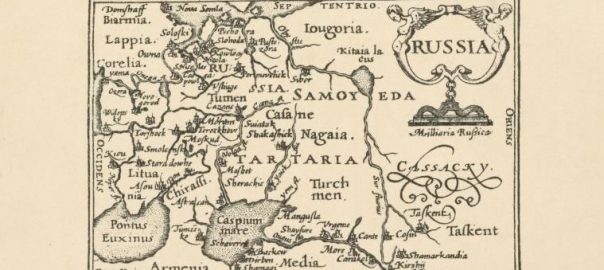1562 was such a big year for this project. 1563 CE seems, by contrast, to be very quiet. I am certain that over here in the Americas, the Spanish and Portuguese settlers were continuing their genocidal activities and in London the Queen and various very rich dudes around her were planning their next investment in the slave trade. But nothing immediately came up for me on those continuing story-lines today so I decided to head over to Asia…
-

Jenkinson map, engraved 1593 Well, not just me, but also the English explorer Anthony Jenkinson. He had been born to a wealthy family in 1529; and in 1558-60 he’d made his first trip to (and through) Russia on behalf of the Crown-backed London investors’ group known as the Muscovy Company. I think he always entered Russia via the northern White Sea. As was the case with nearly all the global explorations undertaken by West Europeans in those times, the over-arching goal was to find a workable route for potential trade with China and India and their riches. On this first trip, Jenkinson traveled overland as far as Bokhara. English-WP tells us his party “found that though the routes to China and India were well known, they were impassable due to wars and banditry along the way. The hostility of the local authorities made their stay precarious, and ultimately they were forced to retrace their steps, leaving Bokhara only shortly before the army of Samarkand arrived to besiege it. After many more hardships, including having to completely re-rig the boat they had left on the Caspian (making their own sails, ropes and cables), they arrived back in Moscow in 1559, but could not travel back to England until the spring of 1560 opened the sea passages again…”
- Jenkinson also “brought a young woman or child from Russia to England, who joined the court of Queen Elizabeth. She became known as ‘Ippolyta the Tartarian’.” I shudder to think about her experiences.
- So okay, here’s our 1563 connection. In that year, Jenkinson was in the middle of his second trip to and through Russia: “He arrived in Moscow in August 1561, with the intent to talk trade terms with Ivan the Terrible. However, he was not capable of having an audience with him until March 1562. From there, Jenkinson traveled across Russia, down the Caspian and into Persia, where he reached the court of Shah Tahmasp, then at Qazvin, and managed to obtain preferential trading deals on behalf of the Muscovy Company. However, he found that the wider objective of breaking into the Indian Ocean trade was blocked by the Portuguese outpost at Ormuz [Hormuz] on the Persian Gulf, and the sale of English goods was limited by competition from the Venetians operating via the much shorter route from the Mediterranean through Syria. Also during this expedition, he made a great impression on Ivan the Terrible who granted a large extension of trading rights to the Muscovy Company… In July 1564 Jenkinson returned to London.” I find all of that really fascinating.
- Jenkinson would make a third expedition in 1566, and his experiences on that trip previewed a lot of what “Western” policies toward non-“Western” nations have been ever since. English-WP says he made this trip in order to settle a dispute regarding the trade deals he had negotiated during his 1561-64 trip. But, “Upon his arrival, in a letter sent back to his friend, Jenkinson mentioned the cruelty that had swept over the Russian territories due to Ivan. In order to successfully negotiate the trade terms, Jenkinson was sent back to England. He was ordered to bring war experts to Russia to help Ivan with his wars. Due to this voyage, Jenkinson successfully negotiated new trade terms with the Russian monarch in September 1567.” In other words, set aside concerns about serious human rights abuses in the interest of winning lucrative arms-exports contracts.
- He also drew some maps that became staples of West European cartography for many decades thereafter. The two shown here were printed in the 1590s.
